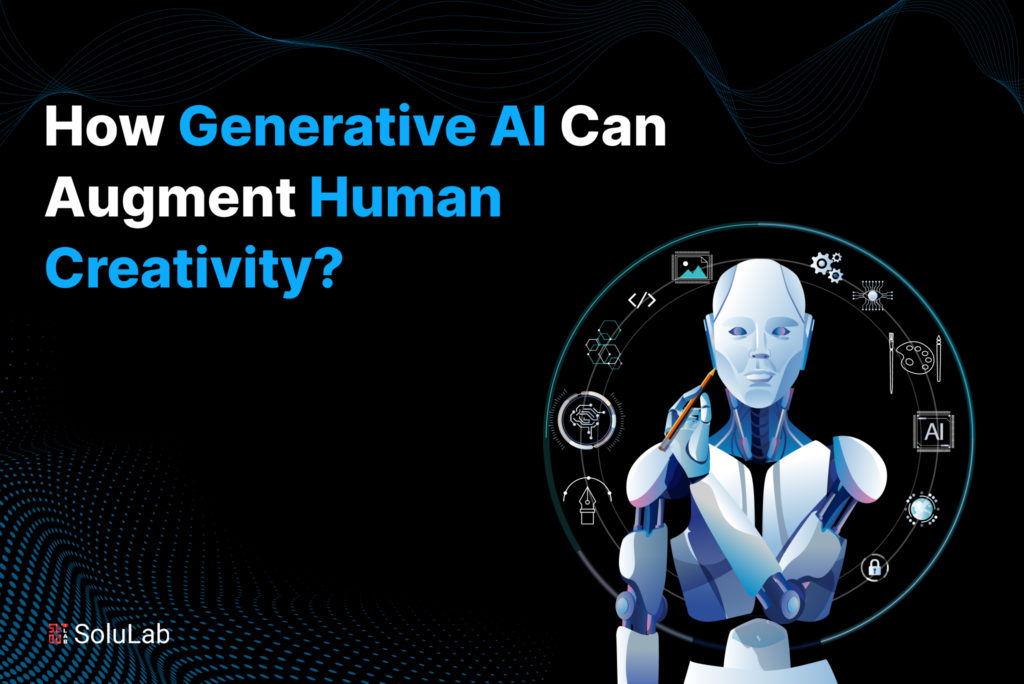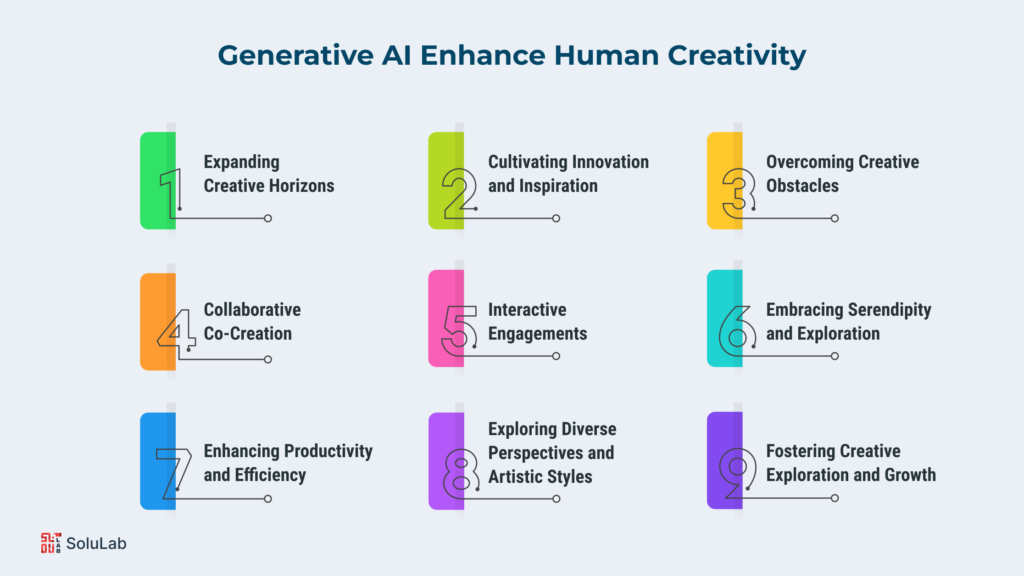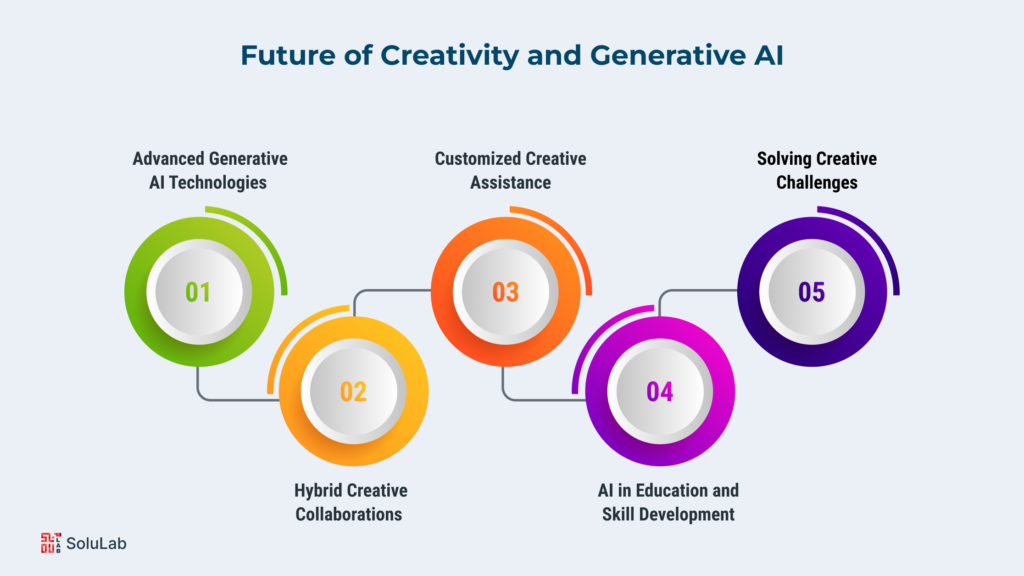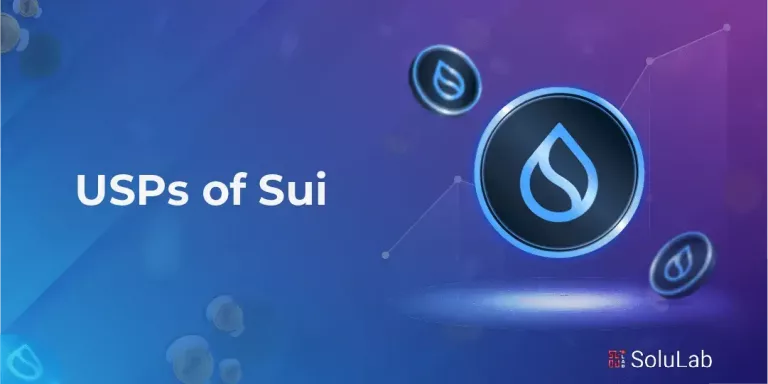
In the ever-evolving landscape of technology, the emergence of Generative AI technology has ignited a captivating conversation about its transformative potential in the realm of creativity. The fusion of Generative AI and creativity represents a dynamic synergy that is poised to revolutionize the way we approach artistic expression, innovation, and problem-solving.
In this blog, we delve into the fascinating world of Generative AI and its role in augmenting human creativity, exploring how these powerful algorithms are reshaping traditional boundaries and opening up new vistas for human ingenuity.
What is Generative AI?
Before diving into how Generative AI can augment human creativity, it’s essential to understand what generative AI is. Generative AI refers to a subset of artificial intelligence that uses neural networks to generate content autonomously. One of the most notable examples is GPT-3, a language model capable of generating human-like text. Generative AI can create content across various domains, including text, art, and music.
Generative AI, with its ability to autonomously create content, has found applications across various domains. Here are some compelling examples of how this technology is making waves:
- Text Generation: Generative AI models like GPT-3 can produce human-like text, making them invaluable for content creation, copywriting, and even automated customer support chatbots. They can craft articles, generate code snippets, and compose emails, streamlining numerous written communication tasks.
- Art Generation: Generative Adversarial Networks (GANs) have empowered AI to generate stunning artwork, illustrations, and even 3D designs. Artists and designers often use these AI-generated pieces as a starting point for their creative projects or as a source of inspiration.
- Music Composition: AI is capable of creating music in a variety of genres and styles. Musicians and composers can use Generative AI to spark new musical ideas or even generate entire compositions. This application has led to the creation of unique soundscapes and musical pieces.
- Video Game Content: In the gaming industry, Generative AI is employed to create dynamic game environments, characters, and quests. Games that adapt to the player’s actions use AI to generate content on the fly, providing a more immersive and personalized gaming experience.
- Drug Discovery: In the field of pharmaceuticals, Generative AI is used to discover new drug candidates by analyzing molecular structures and predicting their effectiveness. This accelerates the drug development process and can potentially lead to the discovery of life-saving medications more quickly.
- Language Translation: Generative AI has enhanced language translation services, making them more accurate and efficient. These models can translate text and even interpret spoken language in real-time, breaking down language barriers in global communication.
Read Our Blog Post: Top 10 Generative AI Development Companies
- Content Personalization: Online platforms, such as streaming services and e-commerce websites, use Generative AI to recommend personalized content to users. This technology analyzes user preferences and behavior to suggest movies, music, products, and more.
- Healthcare Imaging: In the medical field, Generative AI assists in image generation and enhancement for diagnostic purposes. It can reconstruct 3D images from 2D scans, generate synthetic medical images for training AI models, and improve the clarity of medical imaging.
- Autonomous Vehicles: Generative AI plays a crucial role in the development of self-driving cars. These vehicles use AI to generate real-time predictions, detect and respond to obstacles, and navigate complex road conditions safely.
- Natural Language Generation (NLG): NLG models can transform data into human-readable text. They are employed in various applications, such as generating financial reports, weather updates, and sports summaries, providing valuable insights in a digestible format.
These examples illustrate the versatility and impact of Generative AI tools across diverse industries, showcasing their potential to augment human capabilities and transform the way we create, communicate, and innovate. As Generative AI continues to advance, it is likely that we will witness even more groundbreaking applications in the future.
The Interaction Between Human Creativity and Generative AI
In the ever-evolving landscape of technology, the synergy between human creativity and Generative AI has emerged as a remarkable force shaping the way we approach creativity, innovation, and problem-solving. Generative AI, a subset of artificial intelligence, holds the promise of enhancing and augmenting human creativity in unprecedented ways. This symbiotic relationship between humans and machines is a testament to the remarkable potential of combining human ingenuity with the computational prowess of AI.
How Generative AI Can Serve as a Creative Tool?
One of the most profound ways in which Generative AI complements human creativity is by acting as an infinite wellspring of ideas and inspiration. AI models like GPT-3 can swiftly generate a multitude of concepts, helping artists, writers, and innovators overcome creative blocks. Whether it’s ideating for a new product, devising plot twists for a novel, or conceptualizing artwork, Generative AI models can provide an unending stream of fresh ideas, propelling the creative process forward.
Also, creativity often involves mundane and repetitive tasks that can be time-consuming and creatively draining. Generative AI excels at automating such tasks, liberating creators to concentrate on more substantial creative work. It can automate the generation of social media posts, design templates, or data analysis reports, allowing creative professionals to redirect their energy towards the artistic facets of their work.
How Generative AI Can Enhance Human Creativity?

Generative AI solutions possess a unique capability to amplify and complement human creativity. This technology utilizes advanced algorithms and deep learning models to generate content such as text, graphics, music, and even entire virtual worlds. Importantly, it operates not as a substitute for human creativity but as a collaborative partner, enriching the creative toolkit and sparking fresh ideas.
-
Expanding Creative Horizons
Generative AI use cases provide creators with a vast reservoir of information and data, enabling them to venture into uncharted creative territories. Artists can harness these AI models, trained on diverse datasets, to produce original and imaginative content that pushes the boundaries of traditional artistic techniques.
-
Cultivating Innovation and Inspiration
Generative AI has the potential to invigorate human creativity by serving as a wellspring of inspiration. It encourages experimentation and creativity throughout the creative process. Artists can use AI-generated content as a starting point, exploring various modifications, remixes, and interpretations. This iterative and collaborative interaction between human creativity and generative AI inspires artists to push their creative boundaries.
-
Overcoming Creative Obstacles
Creativity can sometimes be stifled by a lack of fresh ideas or creative blocks. Generative AI trends can come to the rescue by acting as a source of creativity and generating original ideas, helping creators overcome these hurdles. It can expose creators to novel combinations, surprising juxtapositions, or contrasting viewpoints, acting as a catalyst to unlock creative potential and break through creative stagnation.
-
Collaborative Co-Creation
Generative AI development solutions facilitate collaborative co-creation between humans and machines. Artists can use AI technologies to generate preliminary sketches, concept art, or musical compositions, which they can later refine, personalize, and imbue with their unique artistic sensibilities. This collaborative process allows artists to infuse their distinct creative vision into the final product while leveraging the capabilities of AI.
-
Interactive Engagements
Generative AI creativity supports interactive and expressive interactions between creators and their audiences. By employing AI-powered systems to create dynamic visual or auditory experiences responsive to user inputs, artists can craft immersive and captivating artistic experiences. This interplay between generative AI and audience participation adds a new dimension of inventiveness and interactivity to artistic expressions.
-
Embracing Serendipity and Exploration
The use of Generative AI in the creative process can lead to unexpected and serendipitous discoveries. By examining the outputs of generative AI models, artists may uncover novel patterns, unconventional concepts, or hidden connections, potentially charting entirely new creative paths. This element of surprise and discovery injects excitement into artistic exploration and pushes the boundaries of creative expression.
-
Enhancing Productivity and Efficiency
Generative AI solutions can enhance the productivity and efficiency of creative endeavors. Through tasks like automating repetitive chores, generating initial drafts or prototypes, or offering creative suggestions, AI algorithms assist artists in streamlining their work processes. This allows artists to allocate more of their efforts toward making intricate creative decisions.
-
Exploring Diverse Perspectives and Artistic Styles
Generative AI & human-AI collaboration simplify the exploration of diverse viewpoints and artistic idioms. Creators can experiment with blending, reimagining, or reinterpreting multiple sources of inspiration, resulting in fresh hybrids and distinctive artistic expressions. By training AI models on various cultural references, historical eras, or aesthetic movements, artists can broaden their creative palette.
-
Fostering Creative Exploration and Growth
Generative AI promotes ongoing creative exploration and growth by providing continuous feedback and educational opportunities. Creators can use AI-generated content as a platform for experimentation, continuous skill development, and the exploration of new creative frontiers. This iterative approach nurtures growth, education, and the advancement of artistic abilities.
Challenges and Limitations of Generative AI in Augmenting Human Creativity
While Generative AI holds immense promise in enhancing human creativity, it also presents a set of challenges and limitations that must be addressed for its responsible and effective integration into creative processes. Understanding these challenges is essential for maximizing the potential benefits of AI while mitigating potential risks:
- Ethical Concerns: Generative AI can produce content that raises ethical questions. AI models trained on large datasets may inadvertently generate biased, offensive, or inappropriate material. Maintaining ethical standards and avoiding the propagation of harmful content is a pressing challenge. Rigorous content moderation and the development of ethical guidelines for AI-generated content are crucial. Human oversight is essential in curating and filtering AI outputs to ensure adherence to ethical principles.
- Quality Control: While Generative AI can produce a vast amount of content, its quality may vary significantly. Ensuring that AI-generated work meets the desired standards can be a challenge, especially in creative fields where subjective judgment plays a crucial role. Human evaluators and quality control mechanisms can help assess and refine AI-generated content. Feedback loops between humans and AI can be established to improve the quality of output over time.
- Data Availability: Generative AI models require extensive training on large datasets, which may not always be readily available, especially for niche or less-studied creative domains. Access to relevant and diverse training data can be a limitation.
Efforts should be made to collect and curate datasets specific to various creative domains. Collaboration between AI researchers and domain experts can help address this limitation. - Computational Resources: Running advanced Generative AI models often demands substantial computational resources, including powerful hardware and significant energy consumption. This can be a constraint for individuals or organizations with limited resources. Advancements in cloud-based AI services and more energy-efficient AI hardware can help mitigate this challenge. Cost-effective solutions should also be explored.
- Overreliance on AI: There is a risk that users may become overly reliant on generative AI, potentially stifling human creativity and innovation. Overreliance on AI-generated ideas or content can limit the diversity and depth of creative output. Encouraging a balanced approach that values human creativity and uses AI as a tool rather than a replacement is essential. Education and awareness campaigns can promote responsible AI use.
- Intellectual Property Issues: Determining ownership and intellectual property rights for AI-generated content can be complex. It raises questions about who owns the rights to content produced by AI and how creators can protect their work from unauthorized use. Legal frameworks and policies need to be developed to address intellectual property issues related to AI-generated content. Clear guidelines for ownership and attribution are essential.
- Lack of Emotional Depth: While AI can assist in generating creative content, it often lacks the emotional depth and nuanced understanding that humans bring to their creations. Artistic expressions may be limited in their ability to convey complex emotions and experiences. Creatives should strive to infuse their unique emotional and experiential perspectives into AI-generated content, ensuring that human emotions remain central in creative works.
Read Blog Post: Generative AI Use Cases in 2024
- Unintended Consequences: The use of Generative AI may lead to unintended consequences, such as job displacement in creative industries or the creation of misleading content. Identifying and addressing these unintended outcomes is a critical challenge. Comprehensive impact assessments and proactive measures can help anticipate and mitigate unintended consequences. Adaptation and reskilling programs can also support individuals affected by automation.
While Generative AI offers immense potential in augmenting human creativity, it is not without its challenges and limitations. Responsible development and deployment of AI, combined with thoughtful human oversight and collaboration, can help harness the power of AI while preserving the integrity and depth of human creativity. Addressing these challenges is an ongoing process that requires collaboration among technologists, creatives, ethicists, and policymakers to ensure that AI remains a valuable creative ally.
The Future of Creativity and Generative AI

Creativity has always been a hallmark of human ingenuity, driving innovation across countless domains, from art and music to technology and science. However, as we stand on the cusp of a new era, the future of creativity is being shaped in unprecedented ways by Generative AI. This transformative technology holds the promise of augmenting, amplifying, and even redefining human creativity. In this exploration of the future, we delve into the exciting prospects and potential challenges that lie ahead at the intersection of human imagination and artificial intelligence.
- Advanced Generative AI Technologies: As Generative AI technologies continue to evolve, we can expect them to become more sophisticated and capable. Improved neural networks, training methods, and data sources will enable AI systems to generate increasingly high-quality and creative content. For example, we might see AI-generated art that rivals the works of famous painters, or music compositions that are indistinguishable from those created by human composers.
Know More: How Generative AI is Transforming Industries
- Hybrid Creative Collaborations: The future will likely bring about a shift in the way humans collaborate with AI. Rather than AI replacing human creativity, we’ll see more hybrid models where AI acts as a creative partner or a tool to amplify human ideas. This collaborative approach will empower creators across various fields to explore new horizons and push the boundaries of what’s possible.
- Customized Creative Assistance: AI systems will become more personalized, tailoring their creative assistance to individual users. Whether you’re a writer, designer, musician, or engineer, AI tools will adapt to your unique style and preferences, offering suggestions and enhancements that align with your creative vision. This level of customization will empower creators to achieve their artistic goals more efficiently.
- AI in Education and Skill Development: Generative AI will play a significant role in education and skill development. Students and aspiring artists can use AI as a creative mentor, offering guidance, feedback, and practical exercises to hone their talents. AI-driven educational platforms will provide accessible and adaptive learning experiences for individuals of all skill levels.
- Solving Creative Challenges: The future of creativity and Generative AI also involves addressing some pressing challenges. One key issue is the potential for AI-generated content to perpetuate biases present in training data. Striking a balance between creative freedom and ethical content generation will be crucial in ensuring responsible AI use.
In summary, the future of human creativity and Generative AI is a landscape filled with both promise and uncertainty. While AI has the potential to enhance human creativity in unimaginable ways, we must navigate ethical, legal, and societal challenges along the way. The key will be to harness the power of Generative AI as a creative tool while preserving the essence of human ingenuity and the depth of human expression. As we venture into this uncharted territory, one thing is certain: the future of creativity will be a dynamic fusion of human and artificial intelligence, ushering in a new era of innovation and artistic exploration.
Concluding Remarks
In conclusion, the symbiotic relationship between Generative AI and human creativity is a captivating journey into uncharted territories of innovation and artistic expression. As we’ve explored throughout this blog, Generative AI has the potential to revolutionize the creative landscape by offering unparalleled assistance, inspiration, and collaborative possibilities. It can automate repetitive tasks, provide limitless variations of creative content, and even challenge us to redefine the boundaries of imagination. However, we must proceed with a mindful approach, addressing ethical concerns, ensuring transparency, and preserving the authenticity of human creativity. The future is bright for those who embrace the possibilities of Generative AI, recognizing it not as a replacement for human creativity but as a powerful tool to augment and elevate our imaginative capacities.
At SoluLab, we are at the forefront of this creative revolution, harnessing the transformative potential of Generative AI to empower businesses and creators across diverse industries. Our team of experts specializes in developing Generative AI development services that seamlessly integrate with your creative processes. Whether you’re an artist looking to explore new artistic dimensions or a business seeking innovative solutions, SoluLab can tailor Generative AI applications to meet your specific needs. Together, we can embark on a journey of boundless creativity, where the synergy between human ingenuity and AI capabilities knows no limits. Contact SoluLab today to hire the best Generative AI developers and discover how SoluLab can help you unlock the full potential of Generative AI in your creative endeavors.
FAQs
1. What is Generative AI, and how does it differ from other forms of artificial intelligence?
Generative AI refers to a subset of artificial intelligence that focuses on creating new content, such as images, text, music, or videos. It uses neural networks and deep learning techniques to generate original and creative output. Unlike other AI systems that primarily analyze data or make predictions, Generative AI’s primary function is to create something new and imaginative.
2. How can Generative AI enhance human creativity?
Generative AI can enhance human creativity in various ways. It can automate repetitive creative tasks, provide inspiration and suggestions, generate a wide range of creative content, and act as a collaborative partner for artists, writers, designers, and innovators. Handling the mundane aspects of creative work, allows humans to focus on higher-level ideation and innovation.
3. What are some real-world applications of Generative AI in creative fields?
Generative AI has found applications in art, music composition, content generation, design, and even video game development. For example, artists use AI to create unique digital artworks, musicians use it to compose music, and content creators rely on AI to automate content production, such as generating product descriptions or news articles.
4. Are there any ethical concerns associated with Generative AI in creativity?
Yes, there are ethical considerations. Generative AI can inadvertently perpetuate biases present in training data, and there are concerns about authorship and copyright when AI contributes to creative works. Ensuring transparency, accountability, and responsible use of AI in creative processes is essential to address these concerns.
5. What role can companies like SoluLab play in harnessing Generative AI for creative purposes?
Companies like SoluLab specialize in developing customized Generative AI solutions tailored to the specific needs of businesses and creators. They can assist in integrating Generative AI into creative workflows, offering technical expertise, and ensuring that AI technologies are used effectively and ethically to augment human creativity.






